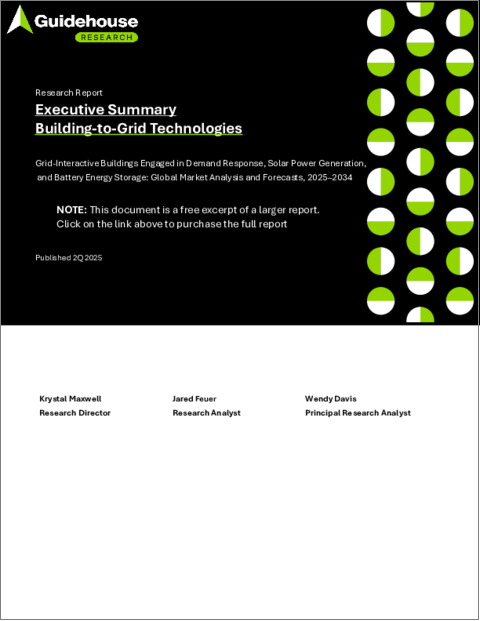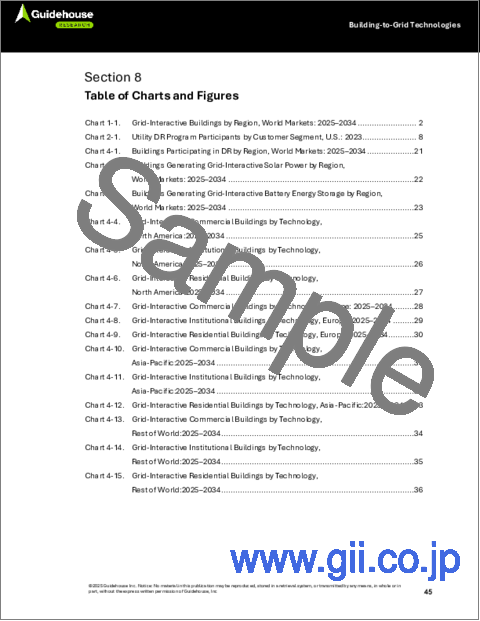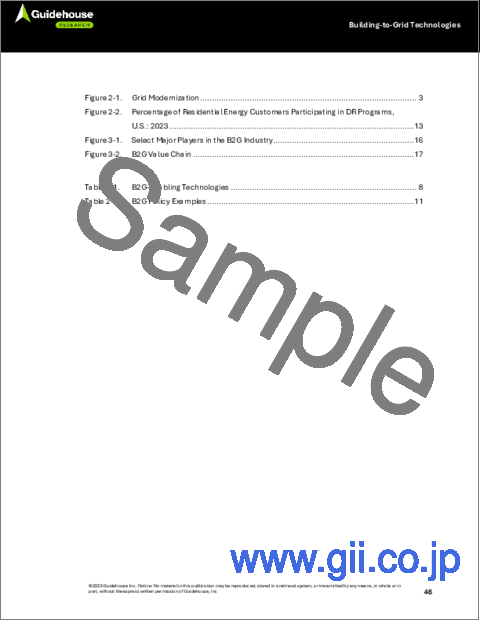|
|
市場調査レポート
商品コード
1714075
ビルディング・ツー・グリッド(B2G)市場Building-to-Grid: Grid-Interactive Buildings Engaged in Demand Response, Solar Power Generation, and Battery Energy Storage - Global Market Analysis and Forecasts, 2025-2034 |
||||||
|
|||||||
| ビルディング・ツー・グリッド(B2G)市場 |
|
出版日: 2025年04月24日
発行: Guidehouse Research
ページ情報: 英文 50 Pages
納期: 即納可能
|
全表示
- 概要
- 目次
増大するエネルギー需要を満たし、再生可能な分散型エネルギー資源(DER)の導入を管理するため、世界の電力網がストレスにさらされる中、電力会社は送電網を安定化させる必要に迫られています。ビルと送電網の相互作用を可能にし、送電網のリソースとして機能するB2G(Building-to-grid)技術は、適切に管理されれば送電網の安定化に役立つ効果的なソリューションです。これらの技術は、電力会社、ビル所有者、住宅所有者、政府、エネルギー消費者に直接的な利益をもたらします。
市場環境は、B2G統合の拡大に有望です。世界各国が電力網の安定化と脱炭素化に取り組むなか、B2G統合はこうした目標を達成するための重要な要素になると思われます。さらに、ビルオーナーや住宅所有者の送電網参加への関心の高まりにより、B2Gを可能にする技術がより望ましいものとなっていることは、世界の導入の増加からも明らかです。B2G統合の障壁の大半は、市場の成熟度に関するものです。B2G統合は黎明期にあるため、市場が成熟するにつれてどの技術、ビジネスモデル、政策が定着するかについては多くの疑問が残る。
当レポートは、デマンドレスポンス、太陽光発電、蓄電池という3つの主要なB2G技術と連動する系統連系ビルの主要動向を分析しています。当レポートでは、これらのB2G技術の概要と、その採用を促進する要因や成長を制限する要因について解説しています。また、2025年から2034年までのグリッド・インタラクティブ・ビルの数を、技術別、ビルタイプ別(商業、施設、住宅)、地域別に予測しています。当レポートは、グリッド安定化を支援するB2G技術を促進するための、B2G利害関係者への具体的な提言で締めくくられています。
目次
第1章 エグゼクティブサマリー
第2章 市場の問題
- 技術の概要
- デマンドレスポンス
- 分散型発電
- 分散型エネルギー貯蔵
- 促進要因
- グリッド安定性の必要性
- グリッド参加への関心の高まり
- 実現技術の普及
- トランザクティブエネルギーの出現
- ポリシーと規制
- 抑制要因
- 高額な初期費用
- 不十分な認識、インセンティブ、受容
- 既存のエネルギービジネスモデルと変化する政策
- ピーク需要の問題
第3章 産業バリューチェーン
- 競合情勢
- 産業バリューチェーン
- 太陽光発電とバッテリーエネルギー貯蔵
- デマンドレスポンス
第4章 市場予測
- 調査手法
- 需要応答予測
- 太陽光発電予測
- バッテリーエネルギー貯蔵予測
- 地域市場予測
- 北米
- 欧州
- アジア太平洋
- その他の諸国
第5章 結論・提言
- 3つの大きなポイント
- 推奨事項
- ユーティリティ
- 政府
- B2Gテクノロジープロバイダー
第6章 頭字語と略語一覧
第7章 目次
第8章 図表
第9章 調査範囲、情報源と調査手法、注記
As global electric grids are put under stress to meet growing energy demands and manage the introduction of more renewable distributed energy resources (DER), utilities will face more pressure to stabilize the grid. Building-to-grid (B2G) technologies-which enable buildings to interact with the electric grid and act as a grid resource-are effective solutions that, if managed properly, can help with grid stabilization. These technologies can directly benefit utilities, building owners, and residential homeowners as well as governments and energy consumers.
Market conditions are promising for increased B2G integration. As countries around the world work to stabilize and decarbonize their power grids, B2G integration will be a key component in achieving these goals. Additionally, increased interest in grid participation from building owners and residential homeowners have made B2G-enabling technologies more desirable, as evidenced by their increased adoption globally. Most of the barriers to B2G integration concern the market's maturity. As B2G integration is in its infancy, many questions remain about which technologies, business models, and policies will take hold as the market matures.
This Guidehouse Research report analyzes major trends in grid-interactive buildings engaged with three primary B2G technologies: demand response, solar power generation, and battery energy storage. The report provides an overview of these B2G technologies and the factors driving their adoption or limiting their growth. It forecasts the number of grid-interactive buildings, segmented by technology, building type (commercial, institutional, and residential), and region, from 2025 through 2034. The report concludes with specific recommendations for B2G stakeholders to promote B2G technologies in support of grid stabilization.
Table of Contents
1. Executive Summary
- 1.1 Scope
- 1.2 Market Drivers
- 1.3 Market Barriers
- 1.4 Global Market Outlook
2. Market Issues
- 2.1 Technology Overview
- 2.1.1 Demand Response
- 2.1.2 Distributed Electricity Generation
- 2.1.3 Distributed Energy Storage
- 2.2 Drivers
- 2.2.1 Need for Grid Stability
- 2.2.2 Increased Interest in Grid Participation
- 2.2.3 Proliferation of Enabling Technologies
- 2.2.4 Emergence of Transactive Energy
- 2.2.5 Policies and Regulations
- 2.3 Barriers
- 2.3.1 High Upfront Costs
- 2.3.2 Insufficient Awareness, Incentives, and Acceptance
- 2.3.3 Incumbent Energy Business Models and Shifting Policies
- 2.3.4 Peak Demand Issues
3. Industry Value Chain
- 3.1 Competitive Landscape
- 3.2 Industry Value Chain
- 3.2.1 Solar Power Generation and Battery Energy Storage
- 3.2.2 Demand Response
4.Market Forecasts
- 4.1 Methodology
- 4.2 Demand Response Forecast
- 4.3 Solar Power Generation Forecast
- 4.4 Battery Energy Storage Forecast
- 4.5 Regional Market Forecasts
- 4.5.1 North America
- 4.5.2 Europe
- 4.5.3 Asia-Pacific
- 4.5.4 Rest of World
5. Conclusions and Recommendations
- 5.1 Three Big Takeaways
- 5.2 Recommendations
- 5.2.1 Utilities
- 5.2.2 Governments
- 5.2.3 B2G Technology Providers





